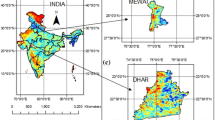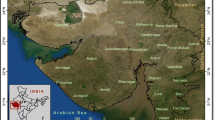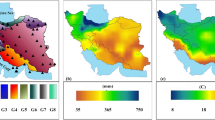Abstract
The aim of this study was to model the relationship between Land Surface Temperature (LST), Normalized Difference Vegetation Index (NDVI), Vegetation Condition Index (VCI), Temperature Condition Index (TCI), Vegetation Health Index (VHI), and Standardized Precipitation Index (SPI) at 3-month timescale in Raya and its environs, Northern Ethiopia. This study answered how NDVI and LST, VCI and TCI, SPI and VHI are related. It also explained better drought indices for meteorological and agricultural drought monitoring. MOD11A2 LST Terra, eMODIS NDVI, and monthly rainfall data of the tropical applications of meteorology using satellite and ground-based observations (TAMSAT) were used. The data were analyzed using a simple linear regression model. The results revealed that the mean LST was high (i.e., between 39.6 and 41.29 °C), while NDVI was poor and unhealthy (i.e., below 0.27) in the lowland area due to unfavorable moisture condition than the mid and highland areas. The regression result indicated that NDVI and LST have a relatively strong negative and significant relationship (R2/P = 0.40/0.01 to R2/P = 0.62/0.00) in all districts of the study area. This study also reported that there is a positive and significant relationship between VCI and TCI (R2/P = 0.38/0.02 to R2/P = 0.63/0.00) in all districts of the study area. Furthermore, this study found that the relationship between SPI and VHI is positive and significant (R2/P = 0.36/0.02 to R2/P = 0.60/0.00) in all districts of the study area. The SPI and VHI indices are suitable for monitoring the incidence of meteorological and agricultural drought. This study may help to improve the understanding of both meteorological and agricultural drought indices relationships.
Similar content being viewed by others
References
Abbas S, Nichol JE, Qamer FM, Xu J (2014) Characterization of drought development through remote sensing: a case study in central Yunnan, China. Remote Sens 6(6):4998–5018
Anbazhagan S, Paramasivam CR (2016) Statistical correlation between land surface temperature (LST) and vegetation index (NDVI) using multi-temporal landsat TM data. Int J Adv Earth Sci Eng 5(1):333
Ayenew T, GebreEgziabher M, Kebede S, Mamo S (2013) Integrated assessment of hydrogeology and water quality for groundwater-based irrigation development in the Raya Valley, northern Ethiopia. Water Int 38(4):480–492
Bisht G, Venturini V, Islam S, Jiang LE (2005) Estimation of the net radiation using MODIS (Moderate Resolution Imaging Spectroradiometer) data for clear sky days. Remote Sens Environ 97(1):52–67
Brown JF, Wardlow BD, Tadesse T, Hayes MJ, Reed BC (2008) The Vegetation Drought Response Index (VegDRI): a new integrated approach for monitoring drought stress in vegetation. GISci Remote Sens 45(1):16–46
Choi M, Jacobs JM, Anderson MC, Bosch DD (2013) Evaluation of drought indices via remotely sensed data with hydrological variables. J Hydrol 476:265–273
Cunha APM, Alvalá RC, Nobre CA, Carvalho MA (2015) Monitoring vegetative drought dynamics in the Brazilian semiarid region. Agric For Meteorol 214:494–505
Evans JD (1996) Straight forward statistics for the behavioral sciences. Brooks/Cole, Pacific Grove
Frey CM, Kuenzer C, Dech S (2012) Quantitative comparison of the operational NOAA-AVHRR LST product of DLR and the MODIS LST product V005. Int J Remote Sens 33(22):7165–7183
Gidey E, Dikinya O, Sebego R, Segosebe E, Zenebe A (2017) Modeling the spatio-temporal dynamics and evolution of land use and land cover (1984–2015) using remote sensing and GIS in Raya, Northern Ethiopia. Model Earth Syst Environ 3(4):1285–1301
Justice CO, Vermote E, Townshend JR, Defries R, Roy DP, Hall DK et al (1998) The moderate resolution imaging spectroradiometer (MODIS): land remote sensing for global change research. IEEE Trans Geosci Remote Sens 36(4):1228–1249
Karnieli A, Bayasgalan M, Bayarjargal Y, Agam N, Khudulmur S, Tucker CJ (2006) Comments on the use of the vegetation health index over Mongolia. Int J Remote Sens 27(10):2017–2024
Karnieli A, Agam N, Pinker RT, Anderson M, Imhoff ML, Gutman GG et al (2010) Use of NDVI and land surface temperature for drought assessment: merits and limitations. J Clim 23(3):618–633
Kogan FN (1995) Application of vegetation index and brightness temperature for drought detection. Adv Space Res 15(11):91–100
Kogan FN (2001) Operational space technology for global vegetation assessment. Bull Am Meteorol Soc 82(9):1949
Kogan F, Adamenko T, Guo W (2013) Global and regional drought dynamics in the climate warming era. Remote Sens Lett 4(4):364–372
Kumar D, Shekhar S (2015) Statistical analysis of land surface temperature–vegetation indexes relationship through thermal remote sensing. Ecotoxicol Environ Saf 121:39–44
Marufah U, Hidayat R, Prasasti I (2017) Analysis of relationship between meteorological and agricultural drought using standardized precipitation index and vegetation health index. In: IOP conference series: earth and environmental science, vol 54, no 1. IOP Publishing, Bristol, p 012008
McKee TB, Doesken NJ, Kleist J (1993) The relationship of drought frequency and duration to time scales. In: Proceedings of the 8th conference on applied climatology, vol 17, no 22. American Meteorological Society, Boston, pp 179–183
Mu L, Wu B, Yan N, Dong L (2006) An adaptation analysis of drought index in Shanxi province of China. In: IEEE international conference on geoscience and remote sensing symposium, 2006. IGARSS 2006. IEEE, Piscataway, pp 290–293
Owrangi MA, Adamowski J, Rahnemaei M, Mohammadzadeh A, Sharifan RA (2011) Drought monitoring methodology based on AVHRR images and SPOT vegetation maps. J Water Resour Prot 3(5):325
Panu US, Sharma TC (2002) Challenges in drought research: some perspectives and future directions. Hydrol Sci J 47(S1):S19–S30
Parviz L (2016) Determination of effective indices in the drought monitoring through analysis of satellite images. Agric For/Poljoprivreda i Sumarstvo 62(1):305–324. https://doi.org/10.17707/AgricultForest.62.1.34
Raghavendra BR (2012) The influence of terrain factors on VCI and TCI of Jogimatti Forest, Chitradurga District, Central University of Karnataka, India, Department of Geology, Gulbarga 585311, Karnataka, India, pp 1–8
Sholihah RI, Trisasongko BH, Shiddiq D, La Ode SI, Kusdaryanto S, Panuju DR (2016) Identification of agricultural drought extent based on vegetation health indices of landsat data: case of Subang and Karawang, Indonesia. Procedia Environ Sci 33:14–20
Singh RP, Roy S, Kogan F (2003) Vegetation and temperature condition indices from NOAA AVHRR data for drought monitoring over India. Int J Remote Sens 24(22):4393–4402
Sruthi S, Aslam MM (2015) Agricultural drought analysis using the NDVI and land surface temperature data; a case study of Raichur district. Aquat Procedia 4:1258–1264
Sun D, Kafatos M (2007) Note on the NDVI-LST relationship and the use of temperature-related drought indices over North America. Geophys Res Lett. https://doi.org/10.1029/2007GL031485
Tucker CJ, Pinzon JE, Brown ME, Slayback DA, Pak EW, Mahoney R et al (2005) An extended AVHRR 8-km NDVI dataset compatible with MODIS and SPOT vegetation NDVI data. Int J Remote Sens 26(20):4485–4498
Wang J, Rich PM, Price KP (2003) Temporal responses of NDVI to precipitation and temperature in the central Great Plains, USA. Int J Remote Sens 24(11):2345–2364
Wang H, Lin H, Liu D (2014) Remotely sensed drought index and its responses to meteorological drought in Southwest China. Remote Sens Lett 5(5):413–422
Wilhite DA (ed) (2000) Drought as a natural hazard: concepts and definitions. In: Drought: a global assessment, vol 69. Routledge, London, pp 3–18
Wolde-Georgis T (1997) El Nino and drought early warning in Ethiopia. Internet J Afr Stud 2. https://ssrn.com/abstract=1589710
Yan N, Wu B, Boken VK, Chang S, Yang L (2016) A drought monitoring operational system for China using satellite data: design and evaluation. Geomat Nat Hazards Risk 7(1):264–277
Zhang A, Jia G (2013) Monitoring meteorological drought in semiarid regions using multi-sensor microwave remote sensing data. Remote Sens Environ 134:12–23
Zhang L, Jiao W, Zhang H, Huang C, Tong Q (2017) Studying drought phenomena in the Continental United States in 2011 and 2012 using various drought indices. Remote Sens Environ 190:96–106
Zhou L, Wu J, Zhang J, Zhao F, Liu M, Zhao L (2010) Assessing the drought monitoring characteristic of time series NDVI indices in crop growing season. In: 2010 IEEE international geoscience and remote sensing symposium (IGARSS). IEEE, Piscataway, pp 2063–2066
Zhou L, Zhang J, Wu J, Zhao L, Liu M, Lü A, Wu Z (2012) Comparison of remotely sensed and meteorological data-derived drought indices in mid-eastern China. Int J Remote Sens 33(6):1755–1779
Acknowledgements
The main author is thankful for the Ph.D. scholarship offered by the TreccAfrica II project. The financial support of Mekelle University, and OSF-ACCAI project of Mekelle University for conducting the research was highly commendable. The National Aeronautics and Space Administration (NASA), United States Geological Survey (USGS), Famine Early Warning System Network (FEWS-NET), and National Meteorological Agency (NMA) of Ethiopia are highly appreciated for the provision of all necessary data. We are grateful for the constructive feedback of the four anonymous reviewers and the editor.
Author information
Authors and Affiliations
Corresponding author
Ethics declarations
Conflict of Interest
The authors state no conflict of interest.
Rights and permissions
About this article
Cite this article
Gidey, E., Dikinya, O., Sebego, R. et al. Using Drought Indices to Model the Statistical Relationships Between Meteorological and Agricultural Drought in Raya and Its Environs, Northern Ethiopia. Earth Syst Environ 2, 265–279 (2018). https://doi.org/10.1007/s41748-018-0055-9
Received:
Accepted:
Published:
Issue Date:
DOI: https://doi.org/10.1007/s41748-018-0055-9











